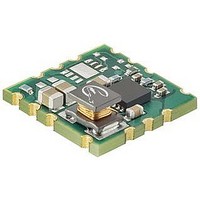OKL-T/1-W12N-C Murata Power Solutions Inc, OKL-T/1-W12N-C Datasheet - Page 16

OKL-T/1-W12N-C
Manufacturer Part Number
OKL-T/1-W12N-C
Description
DC-DC CONVERTER, 5.5V, 5W
Manufacturer
Murata Power Solutions Inc
Datasheet
1.OKL-T1-W12N-C.pdf
(18 pages)
Specifications of OKL-T/1-W12N-C
Dc / Dc Converter O/p Type
Programmable
No. Of Outputs
1
Input Voltage
2.9VDC To 14VDC
Power Rating
5W
Output Voltage
5.5V
Output Current
1A
Approval Bodies
EN, IEC, UL
Supply Voltage
12V
Product
Non-Isolated / POL
Output Power
5 W
Input Voltage (nominal)
12 V
Output Voltage (channel 1)
0.9 V to 5.5 V
Output Current (channel 1)
1 A
Lead Free Status / RoHS Status
Lead free / RoHS Compliant
Available stocks
Company
Part Number
Manufacturer
Quantity
Price
Company:
Part Number:
OKL-T/1-W12N-C
Manufacturer:
RENESAS
Quantity:
1 140
Input Ripple Current and Output Noise
All models in this converter series are tested and specifi ed for input
refl ected ripple current and output noise using designated external input/
output components, circuits and layout as shown in the fi gures below. The
Cbus and Lbus components simulate a typical DC voltage bus. Please note
that the values of Cin, Lbus and Cbus will vary according to the specifi c
converter model.
impedances between the power supply and its load. In order to minimize
circuit errors and standardize tests between units, scope measurements
should be made using BNC connectors or the probe ground should not
exceed one half inch and soldered directly to the test circuit.
Minimum Output Loading Requirements
All models regulate within specifi cation and are stable under no load to full
load conditions. Operation under no load might however slightly increase
output ripple and noise.
Temperature Derating Curves
The graphs in the next section illustrate typical operation under a variety of
conditions. The Derating curves show the maximum continuous ambient air
temperature and decreasing maximum output current which is accept-
able under increasing forced airfl ow measured in Linear Feet per Minute
(“LFM”). Note that these are AVERAGE measurements. The converter will
accept brief increases in current or reduced airfl ow as long as the average
is not exceeded.
itself which is obviously running at higher temperature than the outside
air. Also note that very low fl ow rates (below about 25 LFM) are similar to
“natural convection”, that is, not using fan-forced airfl ow.
closed cycle wind tunnel with calibrated airfl ow. We use both thermocou-
ples and an infrared camera system to observe thermal performance.
V
IN
In fi gure 5, the two copper strips simulate real-world printed circuit
Note that the temperatures are of the ambient airfl ow, not the converter
Murata Power Solutions makes Characterization measurements in a
OSCILLOSCOPE
C
C
L
+
+
BUS
–
–
IN
BUS
TO
= 2 x 100μF, ESR < 700mΩ @ 100kHz
= 1μH
= 1000μF, ESR < 100mΩ @ 100kHz
C
Figure 4: Measuring Input Ripple Current
BUS
L
BUS
CURRENT
PROBE
C
IN
+INPUT
-INPUT
www.murata-ps.com
altitude. Be sure to reduce the derating for higher density altitude.
Output Current Limiting
Current limiting inception is defi ned as the point at which full power falls
below the rated tolerance. See the Performance/Functional Specifi ca-
tions. Note particularly that the output current may briefl y rise above its
rated value in normal operation as long as the average output power is
not exceeded. This enhances reliability and continued operation of your
application. If the output current is too high, the converter will enter the
short circuit condition.
Output Short Circuit Condition
When a converter is in current-limit mode, the output voltage will drop
as the output current demand increases. If the output voltage drops too
low (approximately 98% of nominal output voltage for most models), the
magnetically coupled voltage used to develop primary side voltages will
also drop, thereby shutting down the PWM controller. Following a time-out
period, the PWM will restart, causing the output voltage to begin ramping
up to its appropriate value. If the short-circuit condition persists, another
shutdown cycle will initiate. This rapid on/off cycling is called “hiccup
mode”. The hiccup cycling reduces the average output current, thereby
preventing excessive internal temperatures and/or component damage. A
short circuit can be tolerated indefi nitely.
because you do not have to power down the converter to make it restart.
The system will automatically restore operation as soon as the short circuit
condition is removed.
CAUTION: These graphs are all collected at slightly above Sea Level
The “hiccup” system differs from older latching short circuit systems
Programmable Output 1-Amp iLGA SMT PoLs
+OUTPUT
-OUTPUT
Figure 5: Measuring Output Ripple and Noise (PARD)
09 May 2011
C1 = 1μF CERAMIC
C2 = 10μF CERAMIC
LOAD 2-3 INCHES (51-76mm) FROM MODULE
OKL-T/1-W12 Series
C1
MDC_OKL-T/1-W12 Series.A04 Page 16 of 18
COPPER STRIP
COPPER STRIP
email: sales@murata-ps.com
C2
SCOPE
R
LOAD





















